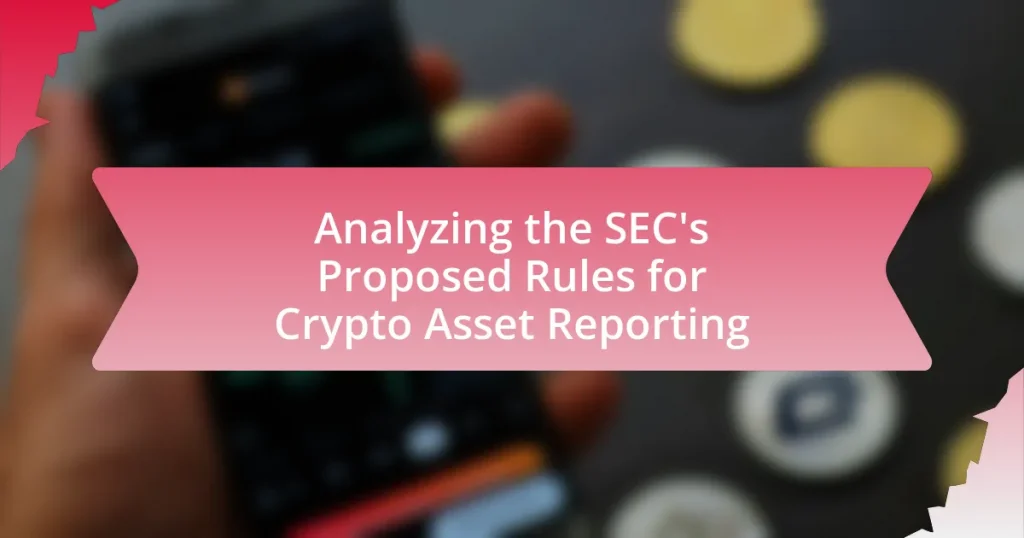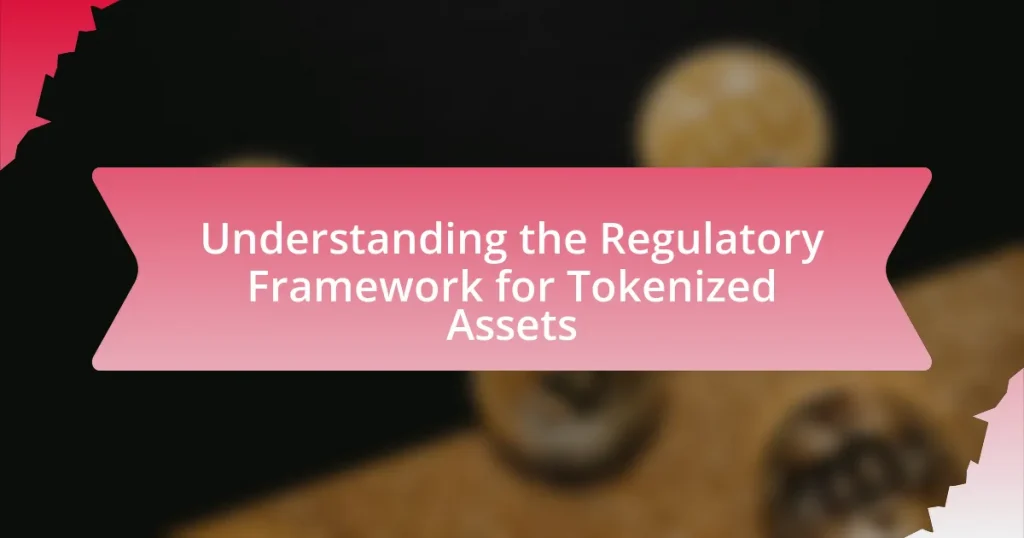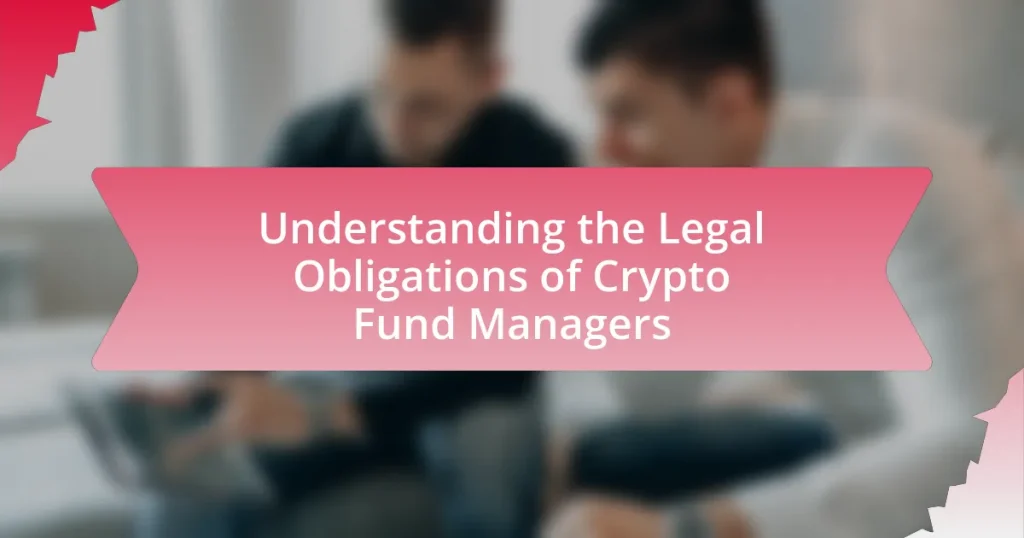The main entity in the article is the Securities and Exchange Commission (SEC) and its proposed rules for crypto asset reporting. The article provides a detailed analysis of these rules, which require registered investment advisers and other entities to disclose information about their crypto asset holdings and transactions to enhance transparency and investor protection. It discusses the motivations behind the proposal, including the rapid growth of the cryptocurrency market and concerns over fraud and market manipulation. Additionally, the article outlines the scope of the rules, the types of crypto assets covered, the impact on the industry, compliance challenges, and the potential benefits for market stability and investor protection. Finally, it highlights the next steps in the rule-making process and resources available for organizations to navigate these regulatory changes.
What are the SEC’s Proposed Rules for Crypto Asset Reporting?
The SEC’s proposed rules for crypto asset reporting require registered investment advisers and certain other entities to report information about their crypto asset holdings and transactions. These rules aim to enhance transparency and investor protection by mandating disclosures related to the valuation, custody, and risks associated with crypto assets. The SEC emphasizes the need for consistent reporting standards to address the unique challenges posed by the rapidly evolving crypto market, thereby ensuring that investors receive accurate and timely information.
Why are these rules being proposed now?
The rules are being proposed now to address the increasing complexity and risks associated with crypto asset transactions. The SEC aims to enhance transparency and investor protection in a rapidly evolving market, as evidenced by the significant growth of crypto assets, which reached a market capitalization exceeding $2 trillion in 2021. This regulatory initiative responds to concerns about market manipulation, fraud, and the need for standardized reporting practices to ensure compliance and accountability among market participants.
What events or trends prompted the SEC to act?
The SEC acted in response to the rapid growth of the cryptocurrency market and increasing concerns over investor protection and market integrity. The surge in cryptocurrency trading volumes, coupled with high-profile incidents of fraud and market manipulation, highlighted the need for regulatory oversight. For instance, the collapse of major crypto exchanges and the rise of unregulated Initial Coin Offerings (ICOs) raised alarms about the potential for significant financial losses among investors. These events underscored the necessity for the SEC to establish clear reporting requirements and regulatory frameworks to safeguard investors and ensure fair market practices.
How do these rules align with existing regulations?
The SEC’s proposed rules for crypto asset reporting align with existing regulations by enhancing transparency and compliance within the financial system. These rules build upon the framework established by the Securities Exchange Act of 1934, which mandates accurate reporting and disclosure of financial information by entities involved in securities transactions. By requiring crypto asset issuers to provide detailed information about their assets, the SEC aims to mitigate risks associated with fraud and market manipulation, similar to the requirements imposed on traditional securities. This alignment is further supported by the SEC’s ongoing efforts to regulate digital assets under the same principles that govern conventional financial instruments, ensuring a cohesive regulatory environment.
What is the scope of the proposed rules?
The scope of the proposed rules encompasses the regulatory framework for the reporting and disclosure of crypto asset transactions by entities under the jurisdiction of the SEC. These rules aim to enhance transparency and accountability in the crypto market, requiring firms to report specific information about their crypto holdings and transactions. The SEC’s initiative is grounded in the need to mitigate risks associated with market manipulation and fraud, as evidenced by the increasing number of incidents in the crypto space.
Which types of crypto assets are covered under these rules?
The types of crypto assets covered under these rules include cryptocurrencies, stablecoins, and digital tokens that are classified as securities. The SEC’s proposed rules aim to regulate these assets to ensure compliance with existing financial regulations. Specifically, the rules focus on assets that meet the criteria of being investment contracts, which are defined under the Howey Test, thereby encompassing a wide range of digital assets that can be considered securities.
Who will be affected by these reporting requirements?
The reporting requirements will primarily affect cryptocurrency exchanges, custodians, and other entities involved in the trading and holding of crypto assets. These organizations will need to comply with the SEC’s proposed rules, which mandate detailed reporting on transactions and holdings. For instance, exchanges must report user transaction data to ensure transparency and regulatory compliance, impacting their operational processes and data management systems.
What are the key components of the proposed rules?
The key components of the proposed rules for crypto asset reporting by the SEC include the requirement for entities to report information about their crypto asset holdings, transactions, and the identities of the parties involved. These rules aim to enhance transparency and accountability in the crypto market, addressing concerns related to fraud and market manipulation. Additionally, the proposed rules mandate that firms maintain detailed records of their crypto transactions and provide regular disclosures to regulators, which aligns with existing financial reporting standards. This approach is intended to ensure that the crypto market operates within a regulated framework, similar to traditional financial markets, thereby protecting investors and promoting market integrity.
What specific reporting requirements are included?
The specific reporting requirements included in the SEC’s proposed rules for crypto asset reporting mandate that entities must report information on crypto asset transactions, holdings, and transfers. These requirements aim to enhance transparency and compliance within the crypto market. For instance, entities are required to disclose the fair market value of crypto assets at the time of transaction, the nature of the transaction, and the identities of the parties involved. This approach aligns with existing financial reporting standards, ensuring that crypto assets are treated similarly to traditional financial instruments, thereby facilitating regulatory oversight and investor protection.
How will compliance be monitored and enforced?
Compliance will be monitored and enforced through a combination of regular audits, reporting requirements, and penalties for non-compliance. The SEC will implement a framework that mandates crypto asset firms to submit periodic reports detailing their holdings and transactions, ensuring transparency and accountability. Additionally, the SEC has the authority to impose fines and sanctions on entities that fail to adhere to these regulations, as evidenced by historical enforcement actions against firms that violated existing securities laws. This structured approach aims to create a robust compliance environment within the crypto asset sector.

How will the proposed rules impact the crypto industry?
The proposed rules will significantly impact the crypto industry by imposing stricter reporting and compliance requirements on crypto asset transactions. These regulations aim to enhance transparency and reduce fraud, which could lead to increased trust from institutional investors. For instance, the SEC’s focus on requiring detailed disclosures from crypto firms aligns with existing financial regulations, potentially leveling the playing field between traditional finance and the crypto sector. This shift may also result in higher operational costs for crypto companies as they adapt to new compliance measures, which could influence their profitability and market dynamics.
What challenges might the industry face with these new rules?
The industry may face significant challenges in compliance with the SEC’s proposed rules for crypto asset reporting. These challenges include the complexity of accurately tracking and reporting diverse crypto transactions, which can vary widely in terms of structure and regulatory requirements. Additionally, firms may struggle with the need for enhanced technological infrastructure to manage the increased data reporting demands, as many existing systems may not be equipped to handle the volume and specificity of information required. Furthermore, the potential for regulatory ambiguity could lead to inconsistent interpretations of the rules, resulting in compliance risks and possible penalties. Historical context shows that similar regulatory changes in other financial sectors have often led to increased operational costs and necessitated extensive training for staff to ensure adherence to new compliance standards.
How can companies prepare for compliance?
Companies can prepare for compliance with the SEC’s proposed rules for crypto asset reporting by implementing robust internal controls and establishing a dedicated compliance team. This preparation involves conducting a thorough assessment of existing practices, identifying gaps in compliance with the new regulations, and developing policies that align with the SEC’s requirements. For instance, companies should ensure accurate tracking and reporting of crypto asset transactions, as the SEC emphasizes transparency and accountability in financial disclosures. Additionally, training employees on compliance protocols and regularly updating them on regulatory changes will further enhance adherence to the proposed rules.
What are the potential costs associated with compliance?
The potential costs associated with compliance include direct financial expenditures, operational adjustments, and potential penalties for non-compliance. Direct financial expenditures may encompass legal fees, consulting costs, and technology investments necessary to meet regulatory requirements. Operational adjustments often involve reallocating resources, training staff, and implementing new processes to ensure adherence to the rules. Additionally, companies may face penalties or fines if they fail to comply with the SEC’s proposed rules, which can significantly impact their financial standing. For instance, the SEC has historically imposed fines that can reach millions of dollars for violations, emphasizing the financial implications of non-compliance.
What benefits could arise from the implementation of these rules?
The implementation of the SEC’s proposed rules for crypto asset reporting could enhance regulatory clarity and investor protection. By establishing clear guidelines, these rules would help reduce uncertainty in the crypto market, encouraging more institutional and retail investors to participate. Increased participation can lead to greater market stability and liquidity, as evidenced by the historical correlation between regulatory clarity and market growth in traditional finance sectors. Furthermore, improved reporting requirements could facilitate better tracking of illicit activities, thereby fostering a safer trading environment and enhancing the overall integrity of the financial system.
How might these rules enhance investor protection?
The proposed rules for crypto asset reporting by the SEC enhance investor protection by increasing transparency and accountability in the cryptocurrency market. These rules require companies to disclose detailed information about their crypto holdings, which helps investors make informed decisions based on accurate data. For instance, by mandating regular reporting of asset valuations and risks, the SEC aims to reduce the likelihood of fraud and misrepresentation, which have historically plagued the crypto space. This increased oversight can lead to a more stable market environment, ultimately safeguarding investors’ interests and fostering greater trust in digital assets.
What impact could these rules have on market stability?
The proposed rules for crypto asset reporting could enhance market stability by increasing transparency and accountability among market participants. By requiring detailed disclosures from crypto asset issuers and exchanges, these rules aim to reduce information asymmetry, which often leads to market manipulation and volatility. Historical data indicates that increased regulatory oversight in financial markets, such as the implementation of the Sarbanes-Oxley Act in 2002, resulted in improved investor confidence and reduced stock price volatility. Therefore, the SEC’s proposed rules could similarly foster a more stable crypto market environment by promoting trust and reducing the likelihood of fraud.

What are the next steps in the rule-making process?
The next steps in the rule-making process involve the Securities and Exchange Commission (SEC) reviewing public comments on the proposed rules for crypto asset reporting, followed by potential revisions to the rules based on that feedback. After this review, the SEC may issue a final rule, which will then be published in the Federal Register, allowing for implementation. This process is guided by the Administrative Procedure Act, which requires agencies to consider public input before finalizing regulations.
How can stakeholders provide feedback on the proposed rules?
Stakeholders can provide feedback on the proposed rules by submitting comments through the official SEC website during the public comment period. This process allows individuals and organizations to express their views, concerns, and suggestions regarding the proposed regulations. The SEC typically announces the duration of the comment period in its release of the proposed rules, ensuring that stakeholders have a specified timeframe to contribute their feedback.
What is the timeline for finalizing the rules?
The timeline for finalizing the rules regarding crypto asset reporting by the SEC is expected to conclude by the end of 2024. This timeline is based on the SEC’s announcement in 2023, which indicated that the proposed rules would undergo a public comment period followed by a review process before finalization. The SEC aims to implement these rules to enhance transparency and regulatory oversight in the crypto asset market.
What best practices should companies follow in response to the proposed rules?
Companies should implement a comprehensive compliance strategy in response to the proposed SEC rules for crypto asset reporting. This strategy should include conducting a thorough assessment of existing practices to identify gaps in compliance with the new regulations. Additionally, companies should establish robust internal controls and reporting mechanisms to ensure accurate and timely disclosures of crypto asset holdings. Training employees on the new requirements and fostering a culture of compliance will further enhance adherence to the proposed rules. Regular audits and updates to policies will help maintain alignment with evolving regulatory expectations. These practices are essential for mitigating risks associated with non-compliance, which can lead to significant penalties and reputational damage.
How can organizations ensure they are ready for compliance?
Organizations can ensure they are ready for compliance by implementing a robust framework that includes regular audits, employee training, and up-to-date policies aligned with regulatory requirements. Regular audits help identify gaps in compliance, while employee training ensures that staff are aware of their responsibilities under the regulations. Additionally, maintaining policies that reflect the latest SEC guidelines on crypto asset reporting is crucial, as these guidelines are subject to change. For instance, the SEC’s proposed rules emphasize the need for transparency and accurate reporting of crypto assets, which organizations must integrate into their operational practices to avoid penalties.
What resources are available to help navigate these changes?
Resources available to help navigate the SEC’s proposed rules for crypto asset reporting include official SEC publications, industry analysis reports, and legal advisory services. The SEC provides detailed guidance documents and FAQs on its website, which outline the proposed rules and their implications for stakeholders. Additionally, organizations such as the Blockchain Association and the Chamber of Digital Commerce offer insights and resources tailored to industry participants. Legal firms specializing in securities law also publish white papers and host webinars to clarify compliance requirements. These resources collectively assist individuals and businesses in understanding and adapting to the regulatory changes.















